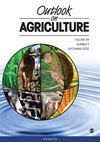Gender and access to complex and gender-biased agricultural technology information and knowledge: Evidence from smart-valleys in West Africa
IF 2.6
3区 经济学
Q1 AGRICULTURE, MULTIDISCIPLINARY
引用次数: 0
Abstract
This paper identifies some ways to effectively transfer complex and gender-biased technology information and knowledge (TIK) to both men and women by analyzing the diffusion of Smart-valleys technology in West-Africa. ANOVA and Fisher's exact tests were applied to data collected from 1120 lowland rice farmers in West Africa. Results confirm the general gender inequality in TIK communication with male farmers having more access to Smart-valleys TIK than female lowland farmers. Only few female communicators were used in Smart-valleys TIK transfer even if they were found to be as efficient as men at communicating and teaching. However, opposite results obtained in Togo in particular reveal that it is possible to ensure gender equality in agricultural TIK communication, even in case of complex and gender-bias technologies, if specific gender mainstreaming and gender equity actions are undertaken during technology diffusion. Women-to-women communication improved female farmers access to Smart-valleys TIK confirming that involving female communicators will reduce gender inequality in TIK diffusion. On-farm demonstration was identified as the most effective approach, not only in Smart-valleys TIK communication, but also in ensuring gender equity in access of both male and female farmers to the TIK. Therefore, on-farm demonstration combined with oral explanations should be adopted as the main approach in complex and gender-biased technologies diffusion in general, and in Smart-valleys diffusion in particular.性别与获取复杂且有性别偏见的农业技术信息和知识:来自西非智能谷的证据
本文通过分析西非智能谷技术的传播,确定了一些有效地向男性和女性传递复杂和性别偏见的技术信息和知识(TIK)的方法。方差分析和Fisher的精确检验应用于从西非1120名低地稻农收集的数据。研究结果证实了TIK沟通中的普遍性别不平等,男性农民比女性低地农民更容易获得智能谷TIK。在智能谷TIK迁移中,只有少数女性沟通者被使用,即使她们被发现在沟通和教学方面与男性一样有效。然而,在多哥获得的相反结果尤其表明,如果在技术传播过程中采取具体的性别主流化和性别平等行动,即使在复杂和性别偏见的技术情况下,也有可能确保农业TIK传播中的性别平等。女性之间的沟通改善了女性农民获得智能谷TIK的机会,证实了女性传播者的参与将减少TIK传播中的性别不平等。农场示范被认为是最有效的方法,不仅在智能谷的TIK沟通中,而且在确保男女农民获得TIK方面的性别平等方面。因此,一般来说,在复杂和性别偏见的技术传播中,特别是在智能谷传播中,应采用农场示范与口头解释相结合的主要方法。
本文章由计算机程序翻译,如有差异,请以英文原文为准。
求助全文
约1分钟内获得全文
求助全文
来源期刊

Outlook on Agriculture
农林科学-农业综合
CiteScore
5.60
自引率
13.30%
发文量
38
审稿时长
>36 weeks
期刊介绍:
Outlook on Agriculture is a peer reviewed journal, published quarterly, which welcomes original research papers, research notes, invited reviews and commentary for an international and interdisciplinary readership. Special attention is paid to agricultural policy, international trade in the agricultural sector, strategic developments in food production, the links between agricultural systems and food security, the role of agriculture in social and economic development, agriculture in developing countries and environmental issues, including natural resources for agriculture and climate impacts.
 求助内容:
求助内容: 应助结果提醒方式:
应助结果提醒方式:


